EL OTRO, EL MISMO / THE OTHER, THE SAME
Los Carpinteros
Opening › Apr 27, 6:00 PM
Apr 28 – Jul 21, 2018
The social utopias of the nineteenth and twentieth centuries have not become reality, but they have not failed, either. They have been bent out of shape, which opens the prospect that they could be bent back. Since 1992, Los Carpinteros—Dagoberto Rodríguez Sánchez and Marco Antonio Castillo Valdes—have made art that registers the changes in Cuban society: the disappointment and frustration that the fresh start into a life of greater solidarity has come to naught. Yet their oeuvre preserves that original impulse and deliberates its forms.
Die sozialen Utopien des 19. und 20. Jahrhunderts sind nicht geglückt, auch nicht gescheitert. Sie sind verformt. Das lässt noch die Aussicht, dass sie wieder in Form kommen. Seit 1992 haben Los Carpinteros, alias Dagoberto Rodríguez Sánchez und Marco Antonio Castillo Valdes, die Veränderungen der kubanischen Gesellschaft künstlerisch aufgezeichnet: die Enttäuschung und Frustration, dass aus dem Aufbruch in eine solidarischere Zeit nichts wurde. Doch ihr Werk bewahrt den Impuls dieses Aufbruchs und denkt seine Formen immer wieder anders.
Los Carpinteros are the chroniclers of a socialist deformation who also point out that it remains to be seen where history will lead. This, their first solo exhibition in a German gallery, was produced in Havana and Madrid over the past several months. It assembles three recent films, a major sculpture, and new watercolors. Let’s start with the films, on view in the gallery’s basement space.
A slaughterhouse: Goats’ throats are slashed, the floor is flooded with blood, piles of steaming entrails sit in garbage cans. Carcasses are hoisted away, then the cleaners move in. The group gathers and a man steps up to deliver a speech. By its end, he will have ruined himself and destroyed his listeners’ trust. Retráctil (2018) retells a turning point in Cuban history, transplanting it into a different setting. In 1971, the secret service pressured the influential poet and critical intellectual Heberto Padilla into making a false confession and denouncing his own ideas. His humiliation and subsequent arrest led many intellectuals to lose faith in the revolution and break solidarity with the Castro regime. Employing a brilliant black-and-white aesthetic, Los Carpinteros reenact Padilla’s forced self-incrimination—the recording has never been made public—as a purge of undesirable elements to recapitulate the resulting shock it meant for the evolution of Cuban society.
Los Carpinteros sind Chronisten einer sozialistischen Deformation und zugleich zeigen sie, dass die Geschichte noch offen ist. Ihre erste Galerie-Einzelausstellung in Deutschland entstand in den letzten Monaten in Havanna und Madrid. Sie vereint drei aktuelle Filmproduktionen, eine Großskulptur und neue Aquarelle. Beginnen wir mit den Filmen im Untergeschoss der Galerie:
Es ist ein Schlachthaus. Ziegenhälse werden geschlitzt, der Boden geflutet von Blut, in Mülltonnen dampfen Gedärme. Kadaver werden verfrachtet, dann wird saubergemacht. Vor versammelter Belegschaft beginnt ein Mann seine Rede, an deren Ende er sich und das Vertrauen seiner Zuhörer zerstört haben wird. Retráctil (2018) ist die Nacherzählung eines Wendepunkts in der kubanischen Geschichte vor veränderter Kulisse. 1971 wurde der einflussreiche Dichter und kritische Intellektuelle Heberto Padilla vom Geheimdienst gezwungen, ein falsches Geständnis abzulegen, in dem er sich selbst zu denunzieren hatte. Seine Demütigung und anschließende Verhaftung brachte viele Intellektuelle dazu, der Revolution nicht länger zu trauen und dem Castro-Regime ihre Solidarität zu entziehen. Los Carpinteros stellen die erzwungene Selbstbezichtigung Padillas, deren Aufzeichnung nie öffentlich wurden, in brillanter Schwarz-Weiß-Ästhetik als Säuberung unerwünschter Elemente nach und rekapitulieren diesen Schock in der kubanischen Sozialentwicklung.


Comodato (2018) is a voyage of observation through the scenes of Cubans’ private lives. An unbroken shot passes through the thirteen rooms of one house. Sumptuous interiors decked out in the accoutrements of wealth give way to more modest and finally humble dwellings. The shift from the living conditions at the top end of Cuba’s social scale to those at the bottom is so gradual as to be almost imperceptible, until the discrepancy becomes increasingly unmistakable. The film refutes the myth that Cuban society knows no class distinctions—and yet its story is not one of division into rich and poor. It is all too conspicuous that each interior is the other’s equal in its distinctive dignity and beauty; the ways in which people make themselves at home are too similar; the continuity of a social sphere with its rising and declining resources too salient in this one environment. Pellejo (2013) is a similar stretch of physically impossible filmic continuity. A simple interior furnished with hardly more than a bed is where life, as sex, plays out. During the intimate act, the lovers age by years and decades. Time passes, has already passed, in desire, in touch, in the couple whose future lies in the past, in the blink of an eye.
On the gallery’s ground floor, an architecture of Moroccan-made clay tiles is as plausible and artful as it is without function. Celosía Copta (2018) hints at a core idea underlying Los Carpinteros’ oeuvre. The two artists and their circle of collaborators and assistants work under the moniker “The Carpenters” for good reason; the label emphasizes manual craftsmanship, signaling their rejection of the lofty idea of creation associated with other conceptions of what artists do. It also aligns their work with a tradition of experience—in existing socialism and beyond—in which one makes with one’s own hands what one cannot buy for money. Skilled manual labor is a means of production in the hands of the many, whether they pitch in out of solidarity or economic deprivation. The group’s pseudonym is a programmatic reminder that social reality is a material process; visions of a different society are a matter of doing, rather than of pure imagination. The tiles as a universal building staple exemplify the idea of construction in Los Carpinteros’ art, highlighting the work of creative social and material-making that remains to be done.
Comodato (2018) ist die Beobachtungsreise in eine kubanische Privatwelt. Eine kontinuierliche Kamerabewegung durchläuft nacheinander die 12 Wohnräume eines Hauses. Zunächst prachtvolle und wohlhabende, bald bescheidenere und schließlich ärmliche Interieurs. Unterwegs wird die Betrachterin der fließenden Übergänge vom oberen zum unteren Rand kubanischer Lebensverhältnisse kaum gewahr, bis die Distanz immer unmissverständlicher wird. Der Film widerlegt den Mythos von der klassenlosen Gesellschaft Kubas – zugleich erzählt er nicht die Geschichte der Spaltung in Arm und Reich. Zu gleichwertig sind die Innenräume in ihrer je eigenen Würde und Schönheit, zu ähnlich die Gepflogenheiten des Arrangements eines eigenen Heims und zu groß die Kontinuität eines sozialen Raums mit seinen auf- und absteigenden Ressourcen.
Ein ähnliches, physisch unmögliches Filmkontinuum ist Pellejo (2013). Ein schlichtes Interieur birgt kaum mehr als ein Bett, in dem das Leben spielt, als Sex. Während des intimen Akts altern die Liebenden um Jahre, Jahrzehnte. Die Zeit läuft ab, sie ist schon abgelaufen im Begehren, in der Berührung, im Paar, das seine Zukunft im nächsten Moment hinter sich hat.
Im Erdgeschoss bilden Tonziegelsteine aus marokkanischer Fertigung eine ebenso plausible und kunstvolle wie funktionslose Architektur. Celosía Copta (2018) weist auf einen Kerngedanken des Werks von Los Carpinteros. Nicht ohne Grund nennen sich das Künstlerduo und sein Kreis von Partnern und Mitarbeitern „Die Schreiner“. Sie grenzen sich mit dem handwerklichen Begriff vom Schaffenspathos anderer Künstlerrollenbilder ab und stellen sich in eine – nicht nur realsozialistische – Erfahrungstradition, in der, was sich nicht kaufen lässt, der eigenen Arbeit überlassen bleibt. Handwerk ist ein Produktionsmittel in der Hand vieler, ob aus Solidarität oder aus Mangel. Das Gruppenpseudonym weist programmatisch darauf hin, dass Gesellschaft ein materieller Prozess ist und soziale Visionen vor allem eine Frage des Tuns sind, nicht nur der Vorstellungskraft. Die Ziegelsteine als universelles Baumaterial zeigen beispielhaft die Konstruktionsidee im Werk von Los Carpinteros, das auf die soziale und materielle Gestaltungsarbeit weist, die noch zu tun ist.Darin liegt übrigens auch eine bewusste Opposition zu Duchamps Readymades, diesen Werkgedanken aus gut gefüllten Kaufhausregalen, deren Inventar nicht nur immer schon fertig ist, sondern vor allem kein Potenzial der Veränderung kennt.
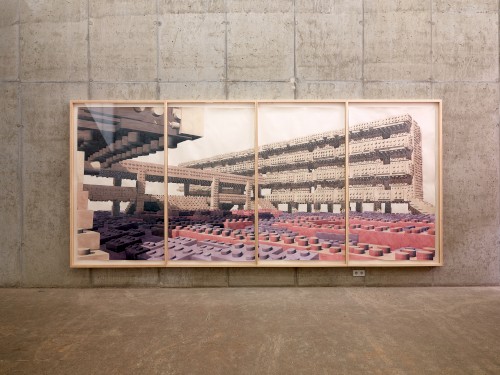
It may be noted that this implies deliberate opposition to the Duchampian readymade, that work-idea straight off well-stocked department-store shelves on which the inventory is not just always already ready-to-use but, more importantly, devoid of all potential for change.
Darin liegt übrigens auch eine bewusste Opposition zu Duchamps Readymades, diesen Werkgedanken aus gut gefüllten Kaufhausregalen, deren Inventar nicht nur immer schon fertig ist, sondern vor allem kein Potenzial der Veränderung kennt.
We do not fuss with or modify readymades. They embody a determinism of immutability. The 15-foot-wide watercolor Ceiba I (2018), too, gets its iconography from the capitalist supermarket shelf, but the product of choice is one whose purport and function is perpetual transformation: Lego bricks. In the depiction, they model one of the numerous new school buildings built in rural Cuba in the 1970s and 1980s—the places where the socialist community would be forged. Many of them are now empty ruins, monuments to the failed dream of education for everyone. Transposed into a Lego world, however, the structure remains an object of play; the egalitarian vision is a project capable of being remodeled, since all building blocks in play can still be moved around.
Forms of progressive modernist Cuban public architecture are a constant in Los Carpinteros’ oeuvre. In watercolors such as Espuma Cúbica cuatro, Díptico (2016), they return as fantastic creations; unburdened by any intended use or the physical realities of construction, functionally and materially weightless, they look like the spaceships of a futuristic art of engineering. These are not blueprints for an architectural vision but rather embody the visionary principle itself. And yet the utopia in the picture speaks in the language of the feasible. Brick was set upon brick, brushstroke upon brushstroke. In this image, the built world is will and imaginative presentation minus all the good as well as contrived reasons why it is supposedly impossible.
And then, finally, a square of black beans, Gran cuadrado de frijoles negros (2017). Kazimir Malevich famously thought of his 1915 Black Square on a white background as the utopian cornerstone of a revolutionary social order. But the revolutions’ grand formulas brought neither Russia nor Cuba any luck. Los Carpinteros transplant Malevich’s modernist icon back from abstraction into the stuff of which actual living conditions are made. Black beans and rice—the national dish of basic needs tops the menu of everyday Cuban life. It is with this reality, rather than with abstract promises, that the construction of a better and more equal life begins, as Los Carpinteros’ art, abstaining from all pathos and illusionism, reminds us.
Text: Alexander Koch / Translation: Gerrit Jackson / Editing: Kimberly Bradley
An Readymades schraubt man nicht rum. Sie verkörpern einen Determinismus der Unabänderlichkeit. Auch das 4,5 Meter breite Aquarell Ceiba I (2018) greift ikonografisch ins kapitalistische Supermarktregal, wählt dort jedoch ein Produkt, dessen Sinn und Funktion die permanente Transformation ist: Lego-Steine. Sie bilden in der Darstellung einen der zahlreichen Schulneubauten nach, die in den 70er und 80er Jahren in den ländlichen Regionen Kubas entstanden, um die sozialistische Gemeinschaft zu bilden. Heute sind viele dieser Schulen leer und ruinös, Denkmäler des Scheiterns vom Traum der Bildung für alle. Versetzt in eine Lego-Welt bleibt der Baukörper indes ein Spielobjekt und die egalitäre Vision ein umbautaugliches Vorhaben, in dem sich alle im Spiel befindlichen Steine noch versetzen lassen.
Formen progressiver öffentlicher Architektur der kubanischen Moderne durchziehen das Werk von Los Carpinteros. In Aquarellen wie Espuma Cúbica cuatro, Díptico (2016) kehren sie als fantastische Gebilde wieder, die jeder Nutzungsbestimmung und bauphysikalischen Realität enthoben sind und in ihrer funktionalen wie körperlichen Schwerelosigkeit wie die Raumschiffe einer futuristischen Ingenieurskunst erscheinen. Es sind keine Baupläne für die eine oder die andere architektonische Vision – sie verkörpern das Prinzip einer solchen Vision. Die Utopie im Bild spricht dabei die Sprache des Machbaren. Sie ist Stein auf Stein gesetzt, Pinselstrich auf Pinselstrich. Die gebaute Welt ist in diesem Bild Wille und Vorstellung minus all die guten wie all die eingebildeten Gründe, warum sie unmöglich sei.
Und schließlich ein Quadrat aus schwarzen Bohnen. Gran cuadrado de frijoles negros (2017). Bekanntlich sah Kasimir Malewitsch sein Schwarzes Quadrat auf weißem Grund von 1915 als den utopischen Grundstein einer revolutionären Gesellschaftsordnung. Doch die großen Formeln der Revolutionen haben Russland so wenig Glück gebracht wie Kuba. Los Carpinteros holen Malewitschs moderne Ikone aus der Abstraktion zurück in die Realität tatsächlicher Lebensverhältnisse. Schwarze Bohnen mit Reis, mit diesem Nationalgericht der Grundbedürfnisse beginnt die kubanische Speisekarte des Alltags. In dieser Wirklichkeit, und nicht in abstrakten Versprechungen, setzt die Konstruktion eines besseren und gleicheren Lebens an, das sich in Los Carpinteros Werk ohne Pathos und Illusionismus in Erinnerung bringt.
Text: Alexander Koch / Translation: Gerrit Jackson / Editing: Kimberly Bradley


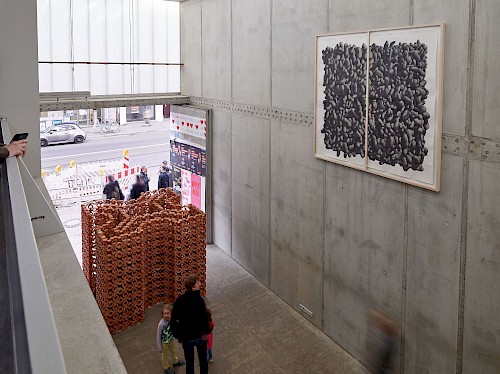






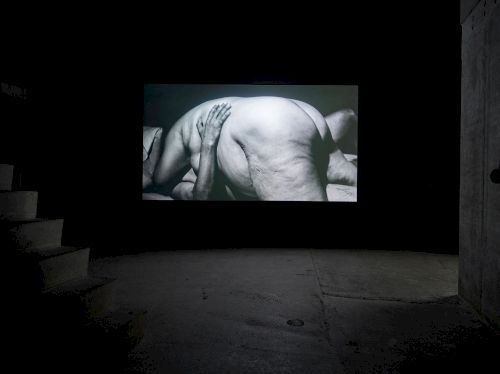


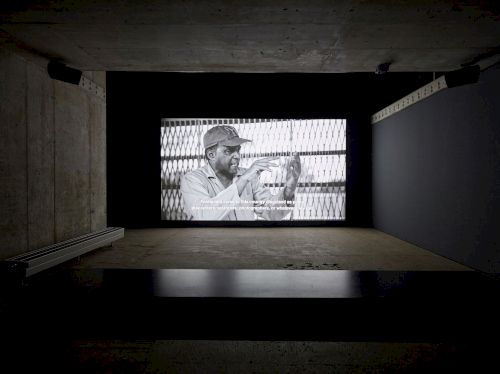



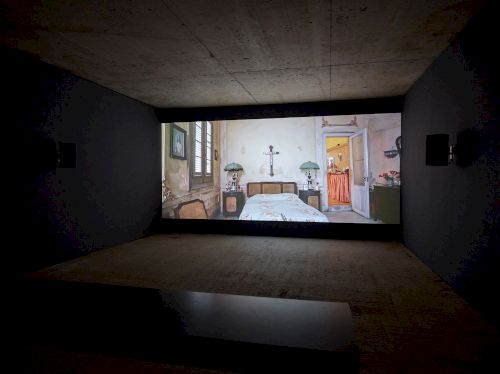


- Current
- Upcoming
- 2025
- 2024
- 2023
- 2022
- 2021
- 2020
- 2019
- 2018
- 2017
- 2016
- 2015
- 2014
- 2013
- 2012
- 2011
- 2010
- 2009